The Cycling Plan should make accommodating cycling a routine part of every street project instead of limiting bike infrastructure to a fixed list of routes that councillors can veto.
By Ryan McGreal
Published November 15, 2013
this article has been updated
Back in 1999, the City of Hamilton published an impressive (for its time) cycling master plan called Shifting Gears. If the City had actually gone on to implement the plan in a timely fashion, Hamilton would today be ahead of the national curve in cycling infrastructure.
However, the plan languished for a decade, gathering dust on the shelf where progressive planning documents in Hamilton go to die. It was so bad that the meagre cycling infrastructure budget went unspent year after year because there was no one on staff to spend it.
Ten years later, the City revived the plan and released a new version, Shifting Gears 2009. This time, the project came with a dedicated staffer to start implementing projects, and the result has been a steady, if slow and modest, expansion of Hamilton's bike lane network.
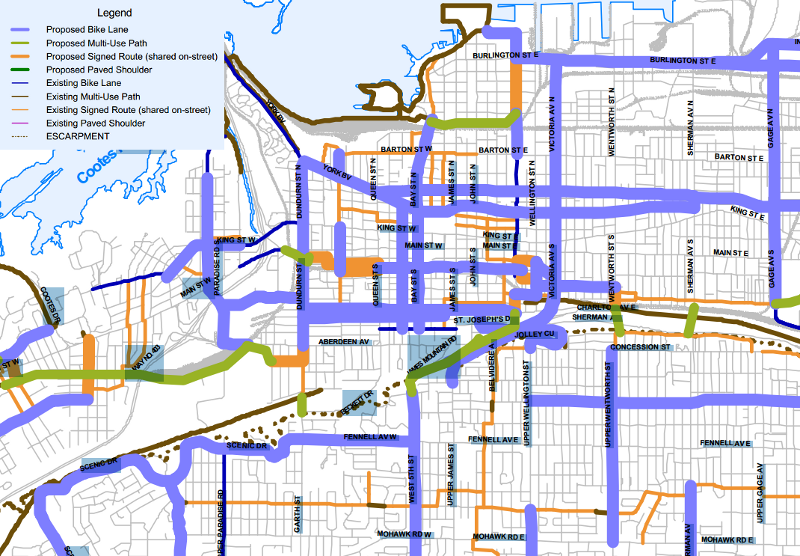
Detail from Shifting Gears 2009 Bike Route Map
I supported the plan because it was a vast improvement on doing nothing, but I was frustrated with the slow implementation schedule - as much as 40 years to, essentially, paint some lines on the road.
As Terry Cooke put it at the time, "They built the Great Pyramid in ancient Egypt in 20 years."
I was also frustrated with the option for councillors to exercise a veto on bike lanes in their wards. Since a network is only as effective as it is continuous, introducing discontinuities - like Queensdale Road east of Upper Sherman and, potentially, west of Upper Sherman as well - leaves the whole network more fragmentary and less usable.
But the problems with Shifting Gears run deeper. It is a fixed snapshot of what the City considered achievable for a cycling plan in 2009, but the state of the art in bike infrastructure design is a moving target.
The evidence is piling up that the safest, most effective bike network is composed of physically protected bike lanes and neighbourhood greenways - which were discussed in the original Shifting Gears but never implemented - not just painted lines next to parallel parked cars.
Yet the City's plan for bidirectional bike lanes on Hunter Street between Liberty Street and Queen Street are separated from automobile traffic by painted lines, not physical barriers. (Not to mention that the lanes are discontinuous between Catharine and MacNab until some time in the unspecified future. Is it that hard to run a bike lane to a train station?)
The proposed Cannon Street protected bike lane looks like it will be physically protected, though we don't have any details yet - but that would never have happened without a massive, very well-organized public engagement campaign.

Rendering of two-way bike lanes on Cannon (Image Credit: Jeremy Johnston)
Other cities are iterating their bike networks, testing ideas and applying best practices - like solid green paint, which significantly improves the perception of bike lanes among non-cyclists - but Hamilton ignores the lessons from other cities and refuses to paint its bike lanes or bike boxes.
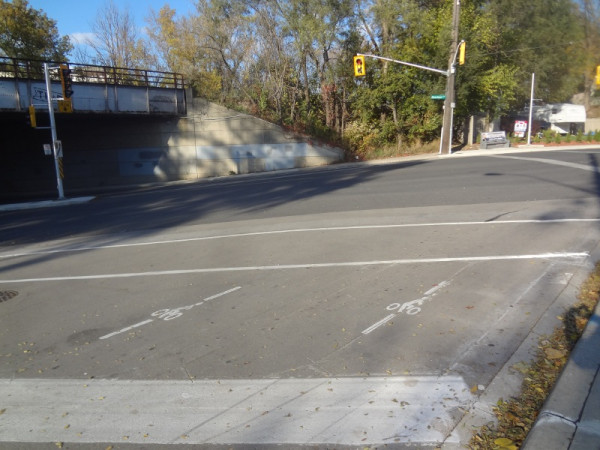
Invisible bike box on Studholme at Aberdeen (RTH file photo)
Worse still, the City has undertaken several major road-resurfacing projects in the last few years that have entirely excluded any new bike infrastructure.
Drivers are delighted that Beckett Drive is open again after a complete rebuild from the roadbed up, but the Escarpment access has no new amenities for walking or cycling. Instead of making space for an upbound bike lane, the city painted double yellow centre lines with a median gap between them - effectively a middle finger to cyclists.
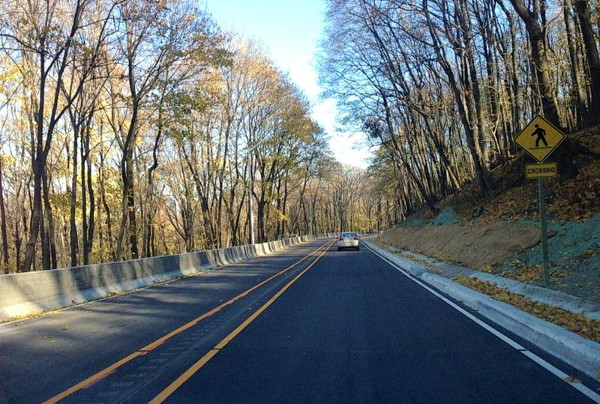
Rebuilt Beckett Drive (RTH file photo)
Of course, Beckett Drive is not on the bike route map, so adding a bike lane wasn't even considered.
Likewise, cyclists were astonished to learn that bikes are forbidden to use the new transit lane on King Street between Mary and Dundurn. The City's explanation noted, "the Cycling Master Plan does not propose bike lanes on King Street." So there.
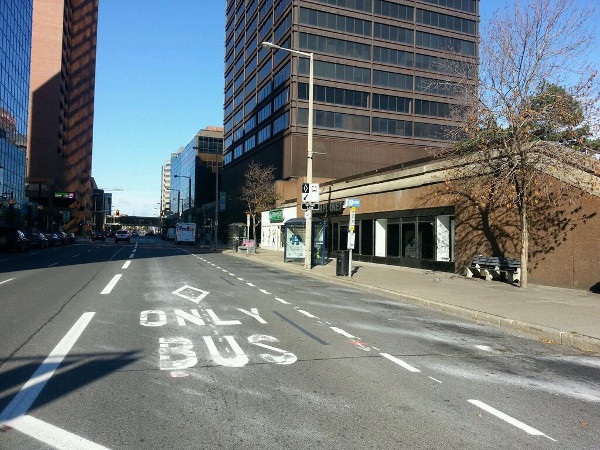
Bicycles not allowed in the King Street transit lane (RTH file photo)
This past summer, three kilometres of King Street East were resurfaced. This would have been an excellent opportunity to build a protected two-way bike lane separated by curbside parking. It would have added almost nothing to the cost of the project.
Instead, the City repainted the street exactly the same as it was before:
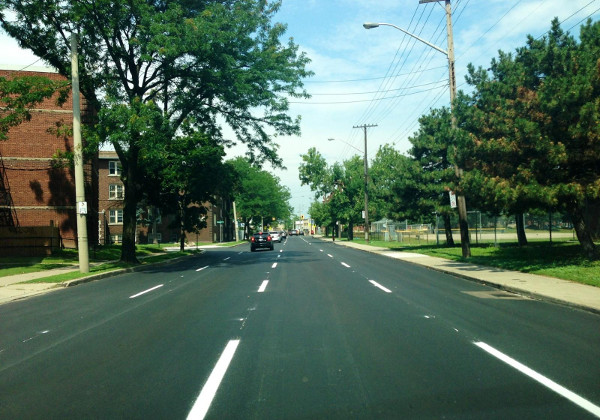
King Street lane repainting: missed opportunity for easy improvements (RTH file photo)
Again, the reason was that King Street is not on the Cycling Plan and, since it's supposed to get a light rail transit line Real Soon Now, it wouldn't make sense to change the street design. (Of course, that didn't stop the City from resurfacing and repainting the street, which will also be wasted when the tracks are installed.)
It wasn't until I read Sara Mayo's excellent summary of the new Pedestrian Mobility Plan that the penny dropped. Mayo wrote:
For those keen policy watchers, it worth noting how different this plan is compared to the city's Cycling Master Plan, Shifting Gears.
The Cycling Master Plan has a map of streets chosen for improvements. That has focused attention on some important areas - for example, it may have been harder to get Council to vote for a bi-directional bike lane on Cannon Street if it wasn't already listed in the CMP.
But that has made it harder to get bike paths and other cycling infrastructure on streets that are not designated in the CMP.
The Pedestrian Mobility Plan has no list of chosen streets, and rather takes the Complete Streets approach that all streets need to better serve all users (especially pedestrians in this case).
My reservations about the cycle plan crystallized: Shifting Gears is a ceiling, not a floor.
Given the very slow pace of new bike lane installations, the plan is used more often to deny bike lanes than to approve them. Even for bike routes that are on the bike plan, Councillors still get to exercise a veto, as a few have already done.
I don't want to minimize the progress that has been made since Shifting Gears was passed. With dedicated staffing, an annual budget and an approved mandate, we went from adding no bike infrastructure, year after year, to making significant and measurable improvements.
Still, the practical result of how Shifting Gears is designed is that as long as it remains our cycling template, it will act more to constrain the expansion of our cycling network than to facilitate it.
What we need is a revision to Shifting Gears to incorporate the concept of "routine accommodation" as defined in the Pedestrian Mobility Plan. As Mayo explains:
Routine Accommodation simply means that street improvements for pedestrian will be added by default to all construction, reconstruction, and maintenance activities on our roads. No additional Environmental Assessment requirements and no special motions at council are needed. Instead, incrementally, one by one, each of our streets becomes more walkable.
This is what the Cycling Plan should do: make accommodating cycling a routine part of every street project. If the goal is to replace a steadily increasing share of automobile trips with bicycle trips, then the bike lane network needs to connect a steadily increasing share of people to a steadily increasing share of destinations.
The City of Chicago recently released an ambitious cycling plan that calls for its 320 km of bike lanes to expand to 1,040 km by 2020. That will include 160 km of new physically protected bike lanes in the next two years and 16 km of new neighbourhood greenways every year.
Instead of shuffling cyclists away from crosstown thoroughfares, the Chicago plan recognizes that cyclists benefit from "more direct connections to destinations" and that protected bike lanes on arterial streets "will help facilitate longer trips for bicyclists."
Contrast Hamilton, which literally tells cyclists to dismount and walk their bikes to impractical parallel routes on streets that would make excellent neighbourhood greenways with relatively minor changes, which will be challenging to achieve because neighbourhood greenways are not in the cycling plan.
Update: This article originally referred to Queensdale Road east and west of Sherman. That should have been east and west of Upper Sherman. RTH regrets the error. You can jump to the changed paragraph.
By Ted Mitchell (registered) | Posted November 15, 2013 at 11:16:57
I think we need to set up a sticky page on problem areas for bike safety. This crowd sourced, focused approach might get more traction than referring to the esoteric Shifting gears plan. The many on/off ramps are a real disaster for actual and perceived cycling safety, and bike lanes are discontinuous where they're needed most.
By Rimshot (anonymous) | Posted November 15, 2013 at 11:22:41
"They built the Great Pyramid in ancient Egypt in 20 years."
And they were a bunch of lazy, disorganized sods!
http://ascelibrary.org/doi/abs/10.1061/40754%28183%2964
By kdslote (registered) | Posted November 15, 2013 at 12:06:19
Frustrating indeed - especially with the number of recent missed opportunities!
Bay Street South is another example. The Cycling Master Plan calls for a bike lane along this stretch, yet this week the city expanded the pedestrian realm near Central School via paint and bollards. In some cases over 1/2 a lane has been set aside for pedestrians, squeezing cyclists in tightly with traffic. Could this space not have accommodated the very bike lane that the CMP calls for?
It's great that pedestrian interests are finally being looked at seriously, but not when they unnecessarily compromise the safety of cyclists. A bike lane is also a great buffer between vehicular traffic and pedestrians!
By kdslote (registered) | Posted November 15, 2013 at 12:15:59 in reply to Comment 94772
Worst of all the stretch of Bay S affected most (between Duke and Bold) is uphill, so cyclists aren't exactly travelling at peak speed! http://goo.gl/maps/vNSZo
By r. (anonymous) | Posted November 15, 2013 at 12:26:02 in reply to Comment 94769
Why not build an undergroud tunnel for cyclists beneath main st. Where they would also be sheltered from inclement weather as well as traffic?
By f. (anonymous) | Posted November 15, 2013 at 12:36:49 in reply to Comment 94776
Because try walking through an underground tunnel. Now imagine you're a woman alone. Now imagine you're elderly. Now imagine you have young children in a stroller. Now imagine you're in a wheelchair. Enough with the expensive insulting stupid ideas so car drivers don't have to slow down for a few seconds to let someone get across the street.
By Pxtl (registered) - website | Posted November 15, 2013 at 12:38:01 in reply to Comment 94777
Obviously the correct answer is jetpacks.
By mikeonthemountain (registered) | Posted November 15, 2013 at 13:11:23 in reply to Comment 94776
Because we are not asking for billions of dollars for an unnecessary subway tunnel.
We're asking for proper street design using a teensy-tiny portion of the road budget.
In a city with a University, College, post industrial renaissance of creative millennials who drive less, etc...
By mikeonthemountain (registered) | Posted November 15, 2013 at 13:21:52 in reply to Comment 94778
Love this idea! Anyone know how to physically manifest Simcity cheat codes?
By Pxtl (registered) - website | Posted November 15, 2013 at 13:46:52 in reply to Comment 94786
Instead of SHIFT+F-U-N-D you have to build your city near oil-rich tar sands.
By mikeonthemountain (registered) | Posted November 15, 2013 at 14:38:00 in reply to Comment 94787
TIL why Calgary is better than us at infrastructure :)
Actually the real reason would be their council AND mayor supporting progressive initiatives, instead of sabotaging them behind the veneer of lip service.
By jason (registered) | Posted November 15, 2013 at 15:49:23
Great article. I was considering writing a piece calling for the abolishment of Shifting Gears. As you say, it has become an excuse to do nothing instead of evolving and expanding with the times.
By mikeonthemountain (registered) | Posted November 15, 2013 at 16:15:25 in reply to Comment 94791
My only fear of abolishing Shifting Gears is that the city will then start removing bike lanes a-la Rob Ford. At least we have a bare minimum commitment in writing at the moment.
By MikeyJ (registered) | Posted November 15, 2013 at 16:31:10
I can't get over how Rapid Transit had King St removed from Shifting Gears - noting they would "investigate bicycle routing issues" themselves, and then used King St not being in Shifting Gears as the reasoning for not allowing cyclists in the bus lane.
There's no questioning that circular logic.
Comment edited by MikeyJ on 2013-11-15 16:32:18
By matthewsweet (registered) | Posted November 15, 2013 at 16:46:36
This type of article makes my day. Because it takes the accepted wisdom of the day for many professionals, that being the importance of master plans, and puts it on its head. My own accepted wisdom included. Excellent piece Ryan.
What you said about state of the art cycling infrastructure applies to the planning process as well. I think the Pedestrian Mobility Plan shows that professionals are starting to recognize that restrictive planning documents like Shifting Gears are obsolete and "routine accommodation" is the wave of the future. Since Shifting Gears is now five years old, it should be coming up for a review (five years being the standard time frame for a review of a planning document of this sort). I think the push can start now to completely overhaul and update Shifting Gears for its 2014 edition.
By Laurence (anonymous) | Posted November 15, 2013 at 17:35:30 in reply to Comment 94790
Although, Calgary has had pretty significant cycling infrastructure for a long time in the form of pathways, totally apart from the road network. I think old drunky Klein may have even supported that one.
By Sara (registered) | Posted November 15, 2013 at 18:19:49
Great article Ryan (and thanks for the plug!)
The solution in my eyes, is of course to push the City to adopt a Complete Streets Policy.
A Complete Streets policy is exactly the sort that Matthew talks about above and would take the routine accomodation approach from the Pedestrian Mobility Plan and apply it for all users.
This would not mean that all streets would get bike lanes, but it does mean that specific consideration would be given in each road project for the safety and convenience of pedestrians, cyclists and transit users along with motor vehicles.
But I'm not convinced that a map of what we want a cycling network to look like in 5 or 10 years is useless. Without a comprehensive network map, using solely a Complete Streets approach could lead to a fragmented cycling network.
The other failing of the current Cycling Master Plan as it stands now is still too focussed on the West End. Look at just the portion of the map in the accompanying photo - how does it make any sense that there's no North-South bike routes between Victoria and Gage?
As Matthew says, the one good thing about ("capital P") Plans is that they do get reviewed on a 5 year cycle, and refined and made better each time. A Luta Continua...
By viennacafe (registered) | Posted November 16, 2013 at 00:07:11
I read an article recently in the London Free Press where it was reported that London loses most of its student population upon graduation. One of the reasons mention was transportation:
"Better transit also is an issue for the young, the survey found, with Eftekarpour saying that would have helped him connect to London faster."
London, Ontario's council holds the same attitude toward transportation as Hamilton. The bus is for people who can't afford cars and cycling is for kids and recreation. And their economy has been sinking for years.
If Hamilton doesn't wake up and smell the future, it risks having a poor one. The dynamic good things happening to bring buzz and attention to the core has a shelf life limited by the inverse relationship between rising lifestyle expectations and disappointments of those investing their energy and their dollars.
By ViennaCafe (registered) | Posted November 16, 2013 at 00:08:51
I can't edit the comment but here is the source of the article cited and quoted: http://www.lfpress.com/2013/11/12/london...
By jason (registered) | Posted November 16, 2013 at 09:45:43 in reply to Comment 94800
This! I've said for months now that city hall has a window to truly capture the next generation that has discovered us. If council continues to cater to a generation leaving the workforce they will be 100% responsible for driving away the energetic talent of the next generation that really wanted Hamilton to be 'it', but are tired of the same old nonsense greatly impeding their quality of life.
By Henry and Joe (anonymous) | Posted November 16, 2013 at 10:22:27 in reply to Comment 94772
Speaking of missed opportunities...a westbound bike lane on York in front of Sir John A to Caroline St. would have been a nice connection from the bike lane that ends at Bay St. when trying to go West from James N. A quick survey of options 1) go south on Park or MacNab - can't do that because someone built a mall that permanently blocks them;) 2) take James to King W - can't because bikes are effectively banned by city hall 3) Go towards Durand and take Aberdeen west- not even car drivers would contemplate this detour 4) take waterfront trail - ok, but sometimes cold and deserted. The only safe option is to take the sidewalk in front of Sir John A., and get to Caroline where one can take side streets to get to Dundurn. This is a ridiculous situation.
By Mark-AlanWhittle (registered) - website | Posted November 16, 2013 at 10:32:35
Does anyone know when the Cannon Street contra-flow bike lane will be implemented?
By MikeyJ (registered) | Posted November 16, 2013 at 14:27:39 in reply to Comment 94808
The design & cost of implementation report is due to council 1st Quarter 2014.
By Noted (anonymous) | Posted November 16, 2013 at 15:03:17 in reply to Comment 94808
http://www.hamilton.ca/CityDepartments/CorporateServices/Clerks/AgendaMinutes/GeneralIssues/2013/November6GeneralIssues.htm
Issue: Bi-directional Bike Lane Project – South Side of Cannon from Sherman to Bay
Date Action Initiated: Sept. 5/13 (GIC 13-017)
Lead Division: Public Works
Status: Sub-sec (e) – Staff to report back re: costs and design of implementation
Due Date: Q1 2014
Council will have a better idea what their options are by April Fool's Day 2014, then decide how to proceed. Implementation date is anyone's guess. 2014 capital budgets will be locked down within a month, so it's possible that the project could be deferred to the 2015-2016 budget cycle.
By SCRAP (anonymous) | Posted November 16, 2013 at 23:20:35
Interesting to note, the Ms Mayo wrote, those who are keen policy watchers, well in my books, policy is a misnomer, since it is never enforced anyways.
If people want change, then they have to break rules, which means not to follow their (governemnt/corporate) agenda.
Is Sarah Mayo writing for Sarah Mayo, or her employer, the SPRC?
By Noted (anonymous) | Posted November 17, 2013 at 16:08:44 in reply to Comment 94811
Another variable is the possibility that the due date itself may be revised, as sometimes happens. Examples:
Issue: Advertising along the LINC and RHVP
Date Action Initiated: Nov. 14/12 (COUNCIL)
Lead Division: Public Works / Corporate Assets & Strategic Planning
Status: Staff to explore maximizing revenues and report back
Due Date: July 8, 2013
Revised Due Date #1: September 5, 2013
Revised Due Date #2: November 20, 2013
http://www.hamilton.ca/CityDepartments/CorporateServices/Clerks/AgendaMinutes/GeneralIssues/2013/June05GeneralIssuesAgenda.htm
http://www.hamilton.ca/CityDepartments/CorporateServices/Clerks/AgendaMinutes/GeneralIssues/2013/August12GeneralIssuesAgenda.htm
Issue: Economic Development Advisory Committee
Date Action Initiated: Sept. 19/12 (GIC 12-025)
Lead Division: P&ED / Economic Development
Status: Report back on establishment of ad hoc Business Development Advisory Cte.
Due Date: Q1 2014
Revised Due Date: Q1 2015
http://www.hamilton.ca/CityDepartments/CorporateServices/Clerks/AgendaMinutes/GeneralIssues/2013/May15GeneralIssues13-011.htm
By Pxtl (registered) - website | Posted November 17, 2013 at 16:14:23 in reply to Comment 94807
Yeah, Iv'e always thought that Sir John A needed a bike-path between the school and the football field, but I imagine there are security/safety reasons against that or something. This would provide a good access to the city's recommended Napier bikeway.
Of course, now that Sir John A is ARCed, one wonders who will own the building and its parkland in a few years. Maybe the city will end up owning that field? That would put them in an even better position to provide a multi-use path.
of course, there's some liability guy taking one look a the York Blvd/Caroline crossing and saying NOPE.
Or the city could just make Bay 2-way because every reason ever.
By Noted (anonymous) | Posted November 17, 2013 at 20:36:47 in reply to Comment 94800
"I read an article recently in the London Free Press where it was reported that London loses most of its student population upon graduation. One of the reasons mention was transportation... London, Ontario's council holds the same attitude toward transportation as Hamilton."
Maybe it's the shock of having to pay full adult fare upon leaving PSE that bums them out? Even so, London Transit Ridership seems to leave most of its peers eating dust. Between 2006 and 2011, LT's ridership growth was five times that of the HSR.
LARGE ONTARIO TRANSIT SYSTEMS
2006 Ridership / 2011 Ridership / % Growth / # Growth
Brampton: 10,139,107 / 16,328,909 / +68.6% / +6,189,802 new riders
Durham Region: 6,942,129 / 9,792,256 / +41.1% / +2,850,127 new riders
London: 18,710,000 / 22,436,392 / +20.4% / +3,725,948 new riders
York Region: 17,108,258 / 19,784,179 / +17.6% / + 2,675,921 new riders
St Catharines: 4,752,760 / 5,559,331 / +17.4% / +806,571 new riders
Mississauga: 29,022,030 / 32,863,821 / +13.7% / + 3,841,791 new riders
Ottawa: 91,839,276 / 103,500,481 / +13.0% / +11,661,205 new riders
Hamilton: 21,165,302 / 21,882,479 / +3.4% / +717,177 new riders
http://www.hamiltoncatch.org/view_article.php?id=1160
By ViennaCafe (registered) | Posted November 17, 2013 at 20:59:17 in reply to Comment 94822
He did indicate "better" transit as opposed to "cheaper" transit.
Ridership in London may be up, but that doesn't make it a better or more desirable system and may speak more to how hard London was hit by the 2008 crash as much of London's employment, outside of home building, was in auto parts.
London has been on a tax freeze since Joe Fontana became mayor so I don't suspect there has been a lot of new funding despite the ridership increase.
By Noted (anonymous) | Posted November 17, 2013 at 22:04:47 in reply to Comment 94826
"While most respondents cited 'work' as the top factor to attract them, many complained it’s tough to find high-quality jobs in their field."
http://goo.gl/nVqqvN
In 2012, youth unemployment (15-24) in London averaged 20.3%.
http://goo.gl/5y15Lu
By viennacafe (registered) | Posted November 17, 2013 at 22:22:20 in reply to Comment 94827
Yes, which is why my first sentence read, in part: "One of the reasons mention was transportation ...". One of, meaning not the only reason.
You seem to be trying to prod an argument out of me and I am an accommodating fellow but not at all passive aggressive.
So, here was argument then, when London was holding meetings on the issue of Creative Cities (paraphrased and in a nutshell): London must decide what it wants to be - whether it wants to be a city, or a collection of suburbs united only by ribbons of roads. An economy built around a model of building houses and cars and dependent 0n the infinite consumption of finite resources, including green fields, is inherently unsustainable economically or ecologically. If London wishes to have a successful and prosperous economy, it must be productive, local, and geared towards 20 years in the future rather than 20 years in the past.
And the same can be said for Hamilton and any other North American city.
By Noted (anonymous) | Posted November 17, 2013 at 23:55:12 in reply to Comment 94828
Not trying to prod, rather to complement. (Transit seems to me a case where Hamilton is in a class all its own, and not in a good way.)
I think we're on exactly the same page, to be perfectly honest: Cities must constantly work to remain competitive if they are to enjoy long-term success, and that edge cannot be found in any of the time-honoured fixes favoured by city pols (such as zero tax increases or endless sprawl, two varieties of magical thinking that mingle far too frequently and with reliably dire results).
Any city mired in 20th century urban thinking/business culture is inevitably going to be at a competitive disadvantage when it comes to fostering a dynamic economy with career-building opportunities for advancement, and thus hanging on to recent grads as well as attracting new talent.
Whether Hamilton rises to that challenge and redefines itself boldly, or settles for a brand refresh of its characteristic incrementalism remains to be seen.
By SeanM (registered) | Posted November 18, 2013 at 09:25:10 in reply to Comment 94797
Yes, because the trails are in parks - it just happens that those linear parks, in floodways along the Bow and Elbow Rivers, happen to lead right downtown. There seems to be much more support for recreational cyclists than utility cyclists.
Calgary just opened a short 7-block long bidirectional lane on 7th St NW that leads to the new Peace Bridge, but on-street bike infrastructure is still lacking there.
By Noted (anonymous) | Posted November 30, 2013 at 13:22:27
http://www.flamboroughreview.com/news/shifting-gears-commuting-families-driven-to-distraction/
By Noted (anonymous) | Posted December 20, 2013 at 07:37:14
http://torontoist.com/2013/12/spotted-colourful-cycling-conflict-zones/
By seancb (registered) - website | Posted December 20, 2013 at 14:22:30 in reply to Comment 96203
This is great - for those averse to link pasting, here's the tl;dr:
The City has decided that old-fashioned pavement-coloured bike lanes aren’t always good enough for Toronto’s cyclists. Road crews are painting certain “conflict zones”—areas where cars and bikes frequently interfere with one another—this attractive shade of green. For the time being, the experiment will be restricted to parts of Bloor Street East near Parliament Street and the viaduct off-ramp, and also bits of Wellesley Street. (And, of course, Sherborne Street has had bright-green bike boxes since last year.)

By seancb (registered) - website | Posted December 20, 2013 at 14:23:25 in reply to Comment 96222
This is how the bike lanes over 403 should cross traffic. Not at a weird sidewalk/bikelane hybrid crossing halfway down the ramp.
By Pxtl (registered) - website | Posted December 20, 2013 at 14:26:32 in reply to Comment 96222
Yup. It's a good compromise, imho - they're not ignoring the cost of maintaining that much green road-paint, but they're using it in places where it's appropriate. That model might be one we could get city staff on-board with here, since they seem to shy away from the cost of blanket-painting a whole bike lane. Every intersection on the new Cannon lane project could use this treatment, for example, just to remind left-turning drivers that this isn't completely a 1-way street anymore and they're turning left across two lanes of bike traffic including an oncoming one.
By Pxtl (registered) - website | Posted December 20, 2013 at 14:28:58 in reply to Comment 96223
Honestly, I still don't think that would be enough. Informational stuff just isn't enough. It's high-speed traffic and a pedestrian crossing with no alternatives. It needs a yield-to-pedestrians/cyclists sign at the bare minimum, if not a complete stop-sign or full signalization.
By seancb (registered) - website | Posted December 20, 2013 at 14:58:53 in reply to Comment 96225
My dream is a proper intersection.
But paint could be a good inexpensive interim solution. I'd run it diagonally across the right lane before the ramp rather than just painting the current crossing. Pedestrians should have their own zebra stripes too.
By brendansimons (registered) | Posted September 20, 2014 at 17:26:02 in reply to Comment 94793
I hope it's not too lat to fix ite, but in some ways Rapid Ready screwed up when they planned for the B Line to take King rather than Main through downtown. Not only did they block any chance at a separated bike lane, but they incurred the wrath of King St businesses losing parking, and mandated the cost of a new bridge over the 403! All this to avoid taking a lane away from our sacred expressway on Main St.
I hope a new council can clear out the back room meddling that kneecaps these plans, but I'm not optimistic.
You must be logged in to comment.
There are no upcoming events right now.
Why not post one?